Best Right Angle Air Powered Drill — Buyers Guide, Top Pick, and Comparison
Brawny, rapid, and industrial-grade — right angle air powered drill units are the daddies in the 90-degree driving arena. Powered by an external compressor, these mighty tools knock out more speed and torque than their electric counterparts — yet retain the snub-head and slimline design for confined-space applications. Lightweight, they stave off fatigue on time-lengthy projects, while their large front or rear-mounted throttle paddles elevate finger and hand stamina. What’s more, compatible with a multitude of accessories, you can also use these drills for polishing, cutting, and finishing.
- Requires 90 PSI at 4 CFM.
- 0.25-inch NPT quick-connector.
- Keyed 0.375-inch chuck.
Air Powered Right Angle Drill Comparison Table
| IMAGE | PRODUCT | DETAILS | ||
|---|---|---|---|---|
|
Best for Speed
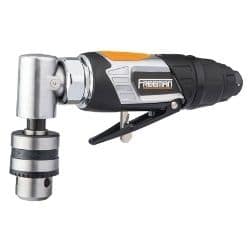
|
Best for Speed
|
Freeman FAT38AD
|
Features
|
Check Price at Amazon Nerds Review Nerds Review |
|
Best Low Noise
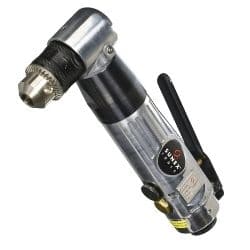
|
Best Low Noise
|
Sunex SX545B
|
Features
|
Check Price at Amazon Nerds Review Nerds Review |
|
Best Home/Garage Use
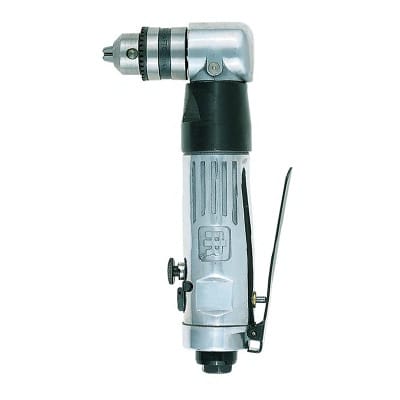
|
Best Home/Garage Use
|
Ingersoll Rand 7807R
|
Features
|
Check Price at Amazon Nerds Review Nerds Review |
|
Best Budget
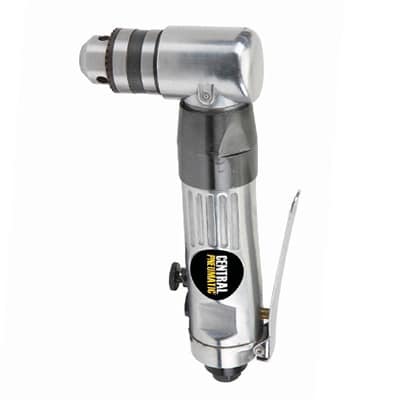
|
Best Budget
|
Central Pneumatic 69495
|
Features
|
Check Price at Amazon Nerds Review Nerds Review |
|
Best Low Profile
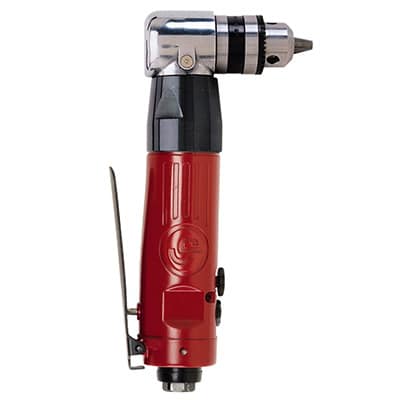
|
Best Low Profile
|
Chicago Pneumatic CP879
|
Features
|
Check Price at Amazon Nerds Review Nerds Review |
Best Right Angle Air Powered Drill Buying Guide
When your projects demand more grunt than a corded or cordless 90-degree machine can provide — it’s time to get hold of a right angle air powered drill.
Typically referred to by trade pros as die grinders — although technically speaking, a true die grinder has the chuck inline, not at a right angle — these powerful machines deliver unsurpassed torque and speed for the most hardcore of applications.
Featuring a slimline design and 90-degree head, these compact units can access areas typically unreachable by a standard air-driven drill. And, compatible with a plethora of accessories, including brushes, cutters, burrs, flat wheels, and points — they offer the ardent DIYer and contractor polishing, sanding, and finishing capabilities in addition to standard drilling.
However, as extreme machines, pneumatic right angle drill units aren’t ideal for basic indoor jobs. Loud, greasy, and requiring the use of an air compressor — they’re usually garage or site-based tools.
When picking your ideal right angle pneumatic drill — consider:
- CFM and pressure requirements of the tool.
- Location of exhaust.
- Decibel level.
- Weight of the tool.
- Variable throttle mounting.
- Speed.
- Torque.
- Knurling on the handle.
- Maintenance aids.
How Does a 90 Degree Pneumatic Drill Work?
Despite being the brawniest of all right angle drill types — the pneumatic format has the simplest driving mechanism.
A compressor airline is attached to the machine’s inlet connector, typically the standard NPT format. As the trigger is squeezed, pressurized air flows into the head chambers, where a series of baffles step down the force to a manageable level. This, in turn, rotates the chuck — whether three-jawed or collet — and drives the bit or die-grinder attachment.
Benefits and Downsides of Air Powered 90 Degree Right Angle Drills
In comparison to mains-powered and cordless machines, pneumatic right-angle drills have the advantages of:
-
- Few internal components — little to go wrong.
- Lack of a complex driving mechanism makes them extremely lightweight.
- Low heft means little likelihood of inducing fatigue.
- Large trigger paddles.
- Even weight distribution — permitting accurate drilling and driving.
- Compatibility with a vast array of accessories.
- Few moving parts mean they are cooler in the hand than electric versions.
- Easy-on-the pocket — although you need to own a compressor.
- High power to weight ratio — massive brawn from a small tool.
However, these air-driven power beasts aren’t for everyone. Compared to the electric versions, they include the downsides of:
-
- Working from a compressor, they’re quite noisy.
- Require an external power unit — typically not owned by DIYers.
- Suitable only for hardcore work — not delicate and precise cabinet drilling.
- Impractical to use indoors.
- Require more user maintenance — including frequent greasing and oiling.
Who Can Use a Pneumatic 90 Right Angle Drill?
Remarkably straightforward to operate — anyone can use an air-powered drill, even your kids (but don’t let them, seriously). Yet, just because you can use one, doesn’t mean you should.
Typically utilized in garages in workshops — due to the compressor requirement — they’re the go-to tool for automotive enthusiasts. Used alongside the other motor air-driven staples of impact wrenches and paint guns — these combi drills, drivers, and grinders are ideal for penetrating metal sheeting, finishing, cutting, and polishing.
That said, right angle pneumatic drills aren’t just for the car nut. They’re excellent grunty tools for anyone whose projects involve hardcore drilling and driving into dense woods, metals, and acrylics — in locations where space is limited.
However, if your jobs involve serious precision — such as cabinet building — don’t go for an air machine, it’s complete overkill. Instead, check out the electric mains-powered and cordless models.
How to Choose the Best Right Angled Air Drill
Here are the key areas to check out when selecting your ideal pneumatic 90-degree unit:
Pressure and CFM Requirement
A crucial consideration — and one that can be costly if ignored.
Always check the PSI demand and CFM requirement (cubic feet per minute) of the pneumatic drill. Although most examples need 90 PSI at 4 CFM — some extreme machines run off higher air pressure.
If your compressor doesn’t reach the necessary force levels, your drill will either be underpowered or fail to function completely.
Exhaust Location
If you’re an experienced air-powered drill user — you’ll already understand the annoyance of waste exhaust gases.
Concomitant to pneumatic tool use, these jet streams of air are typically expelled in an unwanted direction — either catching you directly in the eye or stirring up a whirlwind of drilling debris.
Hence, check that your selected pneumatic 90-degree unit has the exhaust located in a position that isn’t going to blind you. Some models, such as the Freeman FAT38AD, boast a rotatable exhaust deflector — enabling you to direct the air stream into the ideal direction.
Noise Level
Pneumatic drilling is loud.
Not only do you have the thumping of the compressor and the grinding of a drill bit against the base material — but you also have the sound of the driver itself.
If you’re a site contractor, car restorer, or hardcore DIYer, this may not be an issue — as long as you naturally wear ear defenders. However, for the casual user, or those using the tool around family or clients — it may prove problematic.
While all 90-degree air-driven units include some volume-reducing mufflers — some machines are more efficient at noise abating than others. Hence, if this is an area of concern, look for machines that emit 94 dBa or less — such as the Sunex SX545B
Tool Weight
The main reason DIYers and trade-pros opt for a right-angled drill is to access spaces otherwise unreachable by standard inline machines. As such, this can often mean working at unusual and uncomfortable angles — often one-handed.
So, if your tool carries significant heft — it can rapidly induce fatigue.
Admittedly, pneumatic drives are the lightest of all the right-angle drills — but with many weighing in excess of two pounds, they could still seriously impact your drilling stamina, especially when utilized for extended periods.
Therefore, always check out the weight of your 90-degree unit before committing to a purchase. Some manufacturers make lightweight models — for example, the 1.6-pound FAT38AD from Freeman.
Throttle Paddle Mounting
Virtually all 90-degree pneumatic drills feature a large throttle paddle — unlike the single or dual-digit trigger seen on standard corded machines. This reduces hand and finger fatigue and allows you to operate the machine in awkward and uncomfortable positions.
However, I suggest investigating whether your right-angle air-driven unit has a front or rear-mounted paddle.
To be honest, it’s down to personal choice.
A front-mounted trigger — as seen on the Freeman FAT38AD — may seem more familiar to DIY users or pneumatic newbies. It has the chuck speed determined by how hard you squeeze the paddle with your fingers.
Other models, like the Ingersoll Rand 7807R, display a rear-mounted throttle — with the driving intensity adjusted by your gripping tightness.
Torque and Speed
One of the benefits of 90-degree air-powered drills over their electric-driven cousins is their higher levels of torque and rotational rapidity.
However, one is always at the expense of another.
The higher the drill’s speed — its rpm — the lower the torque. And vice versa.
Repetitive driving or drilling projects are more suited to a drill with elevated speed — meaning you can power through the job in the most time-efficient manner. Other work, such as boring into dense metals or extreme grinding would demand more torque.
Hence, always assess your most common project requirements before selecting your right-angle drill.
Handle Knurling
Pneumatic drilling can be greasy and messy — especially when working with automotives. Combine this with a hot and perspiring hand, together with holding the machine in an awkward position — and you have the perfect storm for slippage and drops.
Consequently, I always recommend checking out the level of the 90-degree drill molded knurling — elevating your grip and reducing the likelihood of accidents and mistakes.
Ease of Maintenance
Low on internal components — compared to electric versions — pneumatic right-angle units have little to go wrong. Yet, they do require a little more user maintenance than their corded or cordless counterparts.
It’s therefore prudent to examine how effortless it is to look after your machine. Personally, I’d opt for a drill with a greasing plug — such as the Ingersoll Rand 7807R — that permits you to lubricate the internal components without having to fully dismantle the tool.
Conclusion
When you’re drilling in confined spaces — and nothing but pure brawn and speed will suffice — you need a right-angled pneumatic drill.
Lightweight, compact, and with a 90-degree snub head — these industrial-grade tools will access the most awkward of locations, including engine bays. And, compatible with brushes and cutters, once your drilling work is complete, you can finish or hone your project with one single air-driven machine.
Agreed, these mighty drivers aren’t for everyone. For indoor DIY work on cupboards, cabinets, and timbers, they’re serious overkill. And, requiring a compressor, they lack the portability of a corded or cordless unit.
However, if you’re a trade contractor or dedicated amateur enthusiast who demands the behemoth of the close-quarter driving world — a right angle air powered drill is the solution.
Right Angle 90 Degree Air Powered Drill FAQs
Q: How Large Compressor for Pneumatic Right Angle Drill?
Pressure and airflow requirements can differ between models and manufacturers. However, a typical 90-degree right-angle drill will need around 90 PSI at 4 CFM.
Q: What Is the Best Right Angle Pneumatic Drill?
With its massive 15000 rpm, four-speed regulator, rotatable exhaust, and weighing just 1.6 pounds — for me, the ultimate 90-degree pneumatic air-powered drill is the Freeman FAT38AD.
Q: What Size Air Hose for a Right Angle Air Power Drill?
Although some specialized right angle pneumatic drills require non-standard hose sizing — the majority of units are powered by a quick-connect 0.25-inch NPT hose.
Q: How Long Does the Battery Last on a Right Angle Cordless Drill?
The running time of a 90-degree cordless drill depends on two factors — the mAh rating of the battery and how the unit is used.
The higher the mAh, the longer the cell will last from a single charge. Furthermore, the density of the material you’re addressing, the speed the drill is set at, and the size of the bit can all affect battery running times.
Q: Can I Use An Air Driven 90 Degree Drill as a Wrench?
You could — but your efforts would be fruitless.
While high on torque in the right-angle drill category — they lack sufficient grunt to drive bolts. For that application, you need an impact wrench.
Q: Are Right Angle Pneumatic Drills Difficult to Use?
No. Typically with no more controls than a variable speed throttle — air-powered right-angle machines are more straightforward than their electric cousins.
However, you will need to ensure that you can operate a compressor — at the correct pressure — for the drill to function correctly.

